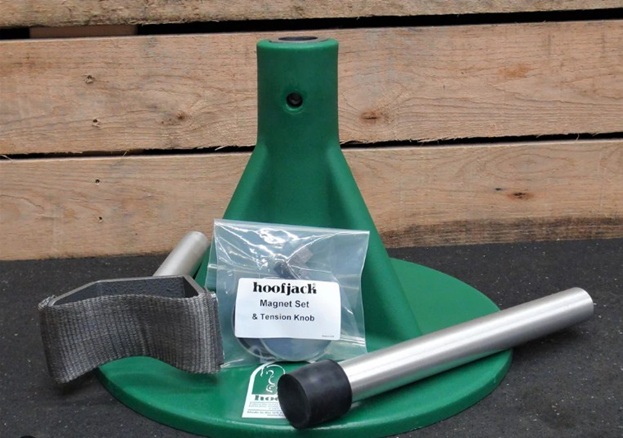Farrier Tool Guide: What You Need for Hoof Maintenance
Proper hoof care is key to optimal horse health, performance and overall well-being. Because of this, you need the right tools for the job. Whether you’re just starting as a farrier or have years of experience, a well-equipped toolkit keeps hoof maintenance efficient and effective. This guide covers the must-have equipment for trimming, shaping, and shoeing, along with their benefits. With the right tools, you can keep hooves in top condition, work with precision, and make the whole process smoother.
Hoof Stand

If you’re a professional farrier, you know how crucial it is to provide proper hoof care while taking care of your body. That’s where a sturdy and professional hoofstand comes in. It’s a game-changer in routine care, therapy, bandaging, and more. Instead of positioning the hoof between your knees or bearing extra weight on your body, a hoof stand helps take the strain off your back and knees, allowing you to focus on the task.
With the right stand, you can pull a shoe, trim, rasp, and even nail on a new shoe without supporting the horse with your body or knees. It provides the stability needed to maintain an effective and safe workflow, and eliminates the physical strain farriers typically experience during these tasks.
Plus, a farrier hoof stand is a lifesaver for older horses or those with limited range of motion. It allows them to lean on the stand rather than on you, helping them maintain an anatomically correct and comfortable stance. This is particularly important when working with horses prone to discomfort or stress.
There are a couple of standout types of hoof stands. Adjustable stands let you change the height, ensuring you can find the perfect level for your comfort. This flexibility makes it easier to work on different horses or switch between tasks without breaking a sweat. On the other hand, magnetic stands use a magnetic surface to hold the hoof in place, offering an extra layer of stability for precise work.
Whether trimming, shaping, or applying shoes, these stands help ensure you’re doing the job right. Investing in a sturdy, well-built hoofstand is a no-brainer if you’re a professional farrier. It’ll not only make the whole process safer for both you and the horse but will also improve your overall efficiency. Just make sure the stand is stable and at the right height to avoid unnecessary back strain.
Pick
A hoof pick is a must-have for any farrier or horse owner. This tool is designed to clean out dirt, mud, and debris from the hooves, which is crucial for preventing infections like thrush or abscesses. Regular cleaning, ideally 2-3 times a week, helps keep hooves healthy and spot potential problems early. A high-quality hoof pick, particularly one made from stainless steel, makes the job easier and more effective.
Nippers
As the essential tools for trimming the hoof wall, they help reduce the length of the hoof, keeping it at the proper size. There are different types, including standard, half-round, and race nippers, each designed for specific hoof shapes.
It’s important to choose nippers with a comfortable grip and keep the cutting edges sharp to prevent damage. Hooves grow about 0.6 cm per month and should be trimmed regularly every 6-8 weeks. Proper trimming can improve movement and reduce injury risk by up to 30%.
Rasps
These are coarse files designed specifically for shaping and smoothing hooves after trimming. They come in two main types: farrier rasps and finishing rasps. To use them effectively, apply even pressure and use long, smooth strokes to avoid uneven surfaces. Regular rasping is essential for refining the hoof’s shape, removing rough edges, and maintaining balance. Well-maintained hooves help with even weight distribution and better movement. Studies show that a well-shaped hoof can improve performance by 10-20%, reducing the risk of injury and promoting overall hoof health.
Farrier’s Knife
A hoof knife is used to trim the frog and pare away dead soles. It’s essential for preventing issues like thrush and ensuring the hoof remains clean and comfortable when riding, working, training, and at all times. There are a few types of hoof knives such as loop, straight, and curved knives, each designed for a different purpose. Here’s a tip for farriers: keep your hoof knife sharp and clean! A sharp blade makes precise cuts much easier. Plus, a well-maintained hoof knife can reduce the risk of hoof issues by 30-40%, promoting better circulation and overall hoof health.
Anvil
An anvil is crucial for farriers who shape and fit shoes to a horse’s hooves. It provides stability, making bending and shaping metal shoes easier for a precise fit. There are two main types: round-horn anvils and flat-horn anvils. Most anvils weigh 32-68 kilograms, offering the right balance for stable work. When using an anvil, position it at a height that allows you to work comfortably without straining your back.
Clencher
This is yet another essential tool for farriers. It’s used to bend the nail heads flat against the hoof wall after a shoe is attached. This keeps the shoe secure and prevents it from coming loose while the horse moves. Proper clenching can cut shoe loss by up to 80%. With that in mind, invest in a durable clencher to make the shoeing process easier. Also, remember to keep it in top shape with regular maintenance, and it’ll serve you well for years.




